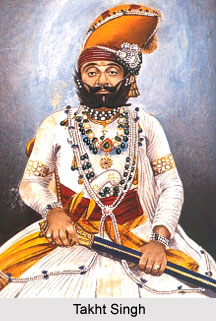 Takht Singh, formally known as Maharajadhiraja Maharaja Shri Takhtsinhji Karansinhji Sahib Bahadur was first the regent and the final Maharaja of Ahmednagar. He served as regent from 1839 to 1841 and later reigned over the territory of Ahmednagar as the titular Maharaja from the year 1841 to 1843. This was done as an outcome of an agreement with the British East India Company. After he conceded Ahmednagar to the princely state of Idar, Takht Singh was regarded as the Maharaja of Jodhpur from 1843 to 1873. Maharaja Takht Singh Sahib Bahadur was born on 6th June 1819 in Ahmednagar. He was the second son of Karan Singh and the grandson of the Maharaja of Ahmednagar (1798- 1835), Sagram Singh.
Takht Singh, formally known as Maharajadhiraja Maharaja Shri Takhtsinhji Karansinhji Sahib Bahadur was first the regent and the final Maharaja of Ahmednagar. He served as regent from 1839 to 1841 and later reigned over the territory of Ahmednagar as the titular Maharaja from the year 1841 to 1843. This was done as an outcome of an agreement with the British East India Company. After he conceded Ahmednagar to the princely state of Idar, Takht Singh was regarded as the Maharaja of Jodhpur from 1843 to 1873. Maharaja Takht Singh Sahib Bahadur was born on 6th June 1819 in Ahmednagar. He was the second son of Karan Singh and the grandson of the Maharaja of Ahmednagar (1798- 1835), Sagram Singh.
In the year 1839, Takht Singh became the regent of the princely state after the death of Prithi Singh his brother. He served as regent of Ahmednagar until the birth of his nephew Balwant Singh, who was announced the ruler of the princely state of Ahmednagar at his birth. He then became as the regent of the new Maharaja and served in the position until the death of his brother`s son Balwant Singh on 23rd September 1841. As a result of this, Takht Singh ascended the throne and became the next Maharaja of Ahmednagar.
After the death of the Maharaja of Jodhpur, Maan Singh in 1843, Maharaja Takht Singh Sahib Bahadur was persuaded to succeed him as he was a member of the Rathore Dynasty, the Rulers of Marwar through his grandfather Sagram Singh. Takht Singh ceded Ahmednagar back to the princely state of Idar to become the Maharaja of Jodhpur and to be recognized by the British administration. He ascended the throne or gadi at the Sringar Chowki in Mehrangarh on 29th October 1843. At a later period of his life, Singh served in the Indian Mutiny or the great revolt of 1857 and in the year 1862 he received a sanad of adoption.
Takht Singh was married for around 30 times and was a constant womanizer through out his life. He died on 13 February 1873 in Jodhpur and was cremated at Jaswant Thara. Maharajadhiraja Maharaja Shri Takhtsinhji Karansinhji Sahib Bahadur was succeeded in Jodhpur by Jaswant Singh II, his eldest son and Pratap Singh, his third son, became the Maharaja of Idar. His daughter Kumari Chand-Kanwar Bai-Lal was married to Maharaja Sawai Ram Singh II of Jaipur.



















